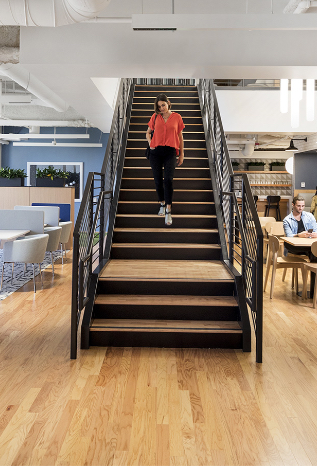During the Covid-19 pandemic, there was an unprecedented rise in the number of online meetings. As many businesses are moving back into the office or taking a hybrid approach to work, you might be wondering whether you should opt for online vs in-person meetings. Well, keep reading to find out about the advantages of face-to-face meetings.
The rise of online meetings
Not many businesses benefited from the pandemic – but video conferencing companies were one of the few that did. Launched in 2013, Zoom was running as a profitable business before 2020 – but with lockdown, the company’s profile really took off. In 2021, Zoom generated $4 billion in revenue, which was a 53% increase year-on-year, and it was one of the fastest-growing apps of the pandemic, during which meeting participants increased by 2900%.
Unable to see family and friends, people turned to Zoom to stay in touch. Pub quizzes went virtual; yoga classes and PT sessions ran on our laptops instead of in gyms and studios; and, of course, businesses across the country hosted meetings over Zoom rather than in-person.
Why are face-to-face meetings important?
Online meetings are great. They allow people to get together from all over the country – and beyond – whilst keeping costs low. For businesses, especially start-ups, travelling for meetings can be costly. Getting colleagues, clients and prospects together online without the expense of transport, meeting room hire, and overnight accommodation can be a great option if you’re trying to cut costs.
However, there are also plenty of benefits of face-to-face vs virtual meetings.
You can better read body language
Non-verbal communication makes up a huge percentage of how we convey messages to one another. It’s commonly said that 90% of communication is non-verbal, a statistic first noted by Dr Albert Mehrabian. He looked at the components of a face-to-face conversation and found that 55% of communication is non-verbal, 38% is vocal, and only 7% is verbal.
Although this sentiment – that less than 10% of communication is through words – is widely reported, it’s not strictly true. Or, at least, it’s not how Dr Mehrabian meant his research to be understood. In his studies, he was looking at one specific context: how we communicate feelings and attitudes, such as liking and disliking, and how the tone of voice and facial expression becomes important when the situation is ambiguous, helping you to figure out whether the person you’re speaking to likes or dislikes something.
So, although it’s not true that 90% of communication is non-verbal, body language is still hugely important when it comes to understanding how other people feel in any given situation. On video calls, people can turn their cameras off. And even if they don’t, you can only see the people you’re speaking to from the shoulders up, making it difficult to read their body language.
Non-verbal communication includes things like:
- Crossed legs
- Crossed arms
- Open palms
- Maintaining eye contact
- Using hand gestures
- Slouching
Being able to read non-verbal communication is an important skill, and can help in business meetings ranging from sales pitches to job interviews. So, the next time you have an important meeting in the diary, consider booking an in-person meeting to benefit from the subtle cues conveyed through body language.
Natural collaboration
Have you ever had an online meeting where you’ve tried to encourage brainstorming and idea generation, but everyone seemed unengaged and distracted? You’re not alone. A study published in Nature, found that video calls reduce creative collaboration and group innovation. Participants were paired together and randomly selected to work together either in person or virtually, then ranked by the number of ideas generated. The pairs that worked together virtually came up with fewer ideas than those that collaborated in person.
That suggests that brainstorming might come more naturally when you get together in person, rather than over video – another great benefit of face-to-face vs virtual meetings.
Build better relationships
Some types of meetings are just better in person. Onboarding new staff, for example, can be tricky online. Good onboarding goes beyond ensuring your new start has a laptop and access to the necessary documents. It also includes things like:
- Making your new start feel welcome, whether with a tour of your office space, a team breakfast, or a manager one-to-one
- Creating a culture where the new employee is free to ask questions of the other staff
- Learning on the job and shadowing other members of staff
- Making sure they understand their job role, expectations, and company mission and vision
Much of this type of onboarding happens organically in person. It’s more difficult to recreate water cooler chats, job shadowing and strong relationships virtually, with fewer opportunities to get to know colleagues outside of work chat, and limited visibility over whether they’re free to support with ad-hoc questions. So if possible, you might want to consider having at least some of your onboarding meetings in person. After all, having a great onboarding programme can increase staff retention by 82%.
But it’s not only onboarding that can be better in person. Other types of meetings can also benefit from face-to-face treatment – not least sales meetings, where it’s easier to build that all-important rapport. Discussions about sensitive topics are also far better when face-to-face, where there’s less room for misinterpretation and more opportunity to show empathy and understanding.
Limit distractions
When on video calls, it’s easy to get distracted. From scrolling through your phone to turning off your video and hanging out your laundry, it’s all too easy to focus on anything but the meeting. In fact, one study found that:
- 7% of employees are distracted during virtual meetings
- 55% of staff check their emails during virtual meetings
- 47% prefer to have face-to-face meetings
If you want to be sure that you have the full attention of everyone, get the team together in your office space.
Book your next meeting
So now you know why face-to-face meetings are superior, it’s time to get your next meeting in the diary. If you don’t have an office of your own, you can rent a day office or temporary office space without long-term contracts or commitments. And if you have a hybrid work culture, it’s easy to host zoom and in-person meetings. We offer everything you need from high-speed internet to ensure your online guests stay connected, to a staffed reception service to direct your in-person attendees to the right meeting room.

